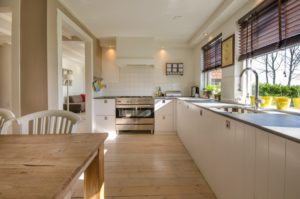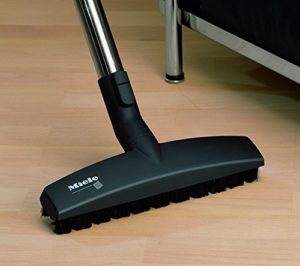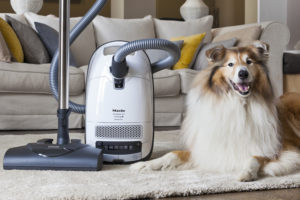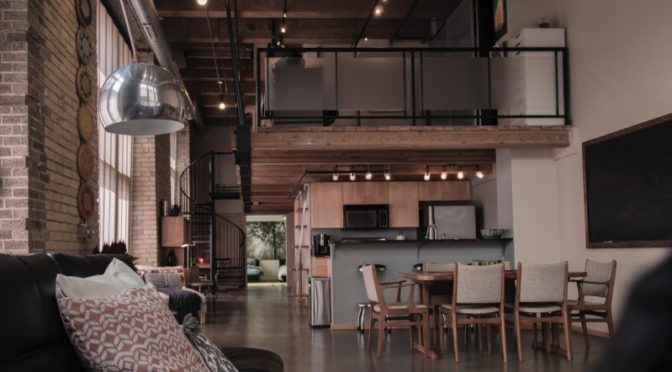
It’s easy to spend a lot of money when outfitting a kitchen, whether when choosing a range (we like the Kucht KRG3080U) or when choosing your floor. You can choose more traditional options or even venture into kitchen hardwood flooring if you dare. But presuming you’re not interested in spending $30 (or more!) per square foot to turn your kitchen floor into a surface fit for Hollywood, you can get costs beneath $1 per square foot by keeping some key points in mind. Today we’ll look at what’s important and what’s not when searching for cheap, yet quality, kitchen flooring.
When searching for affordable and durable kitchen flooring, what’s important, and what’s not?

If you want to get the most value for your money, you need to know what to prioritize. A good and financially sensible kitchen floor most be simple to install. If you can’t install it on your own and need to call in professionals, you’re automatically going to pay hundreds of dollars more. Next, it’s got to be durable and readily cleanable. You’re not going to save money if you buy a floor one year and find yourself replacing it the next because it’s already falling apart or embedded with stains you can’t remove to save your life.

With these rules in mind, you’re essentially going to limit your search to vinyl and laminate floors. There are other durable options, like ceramic and porcelain tiles, that are next to impossible to install on your own, while floors like concrete, while durable and cheap, are simply uncomfortable for most people, particularly as we age. Now that we know what the main options are when on a budget, let’s take a closer look at each.
Consider vinyl flooring due to its budget pricing and ease of installation

If you want a DIY-friendly kitchen floor, vinyl is about as good as it gets. Starting at well under a dollar per square foot, it can also be one of the cheapest floors to install, particularly if you have a well-maintained subfloor, as you will typically be able to install it directly on top of your subfloor (or any other existing floor) without needing to add new underlayments. Vinyl, which is essentially plastic sheeting, is avaliable in a range of styles, looks, installation methods, and price ranges. You’ll usually pay the least for peel-and-stick types of vinyl, such as tiles and planks. Sheet vinyl will cost a bit more. In general, we’d recommend luxury plank vinyl as the best overall option for DIYers, as it’s thicker than normal tiles and clicks together for a simple floating floor installation. The main advantages of vinyl, aside from its price, are its impermeability to water, its forgiving and easy to clean nature, and its softness underfoot compared to harder surfaces like tiles.
If you don’t want vinyl, plastic laminate flooring is the next best option

Presuming you don’t wan to deal with vinyl, your best alternative will probably be a laminate floor. However, you’re going to give up some of the advantages of vinyl, such as its water resistance. While laminate planks are highly resistant to scratches and stains, the planks are inevitably separated by seams, and water can damage those seams. In a kitchen, all it takes is a forgotten spill or a dishwasher with a slow leak to lead to plank bulge. As a result, to keep your laminate in good condition, you’ll want to avoid standing water, and it’s best to simply not bother wet mopping.
That said, if you choose laminate, you’ll enjoy some of the lowest prices per square foot for any bare floor; you can find laminate starting at just over $1 per square foot, and if you invest in water-resistant laminates, which are designed to keep standing water at bay for a certain amount of time (e.g., 24 hours), you can buy it for a bit more–you’ll want to budget at least $3 per square foot. Laminate is a good choice for people interested in the look of a more expensive floor covering (e.g., hardwood, marble stone, or tiles) without paying premium prices. It’s also extremely easy to install as a floating floor. However, its weaknesses involve its susceptibility to moisture as well as the inability to clean it with a wet mop.
Which vacuum cleaners provide the best cleaning power for kitchen (and household) flooring?

No matter which floor you choose for your kitchen, you’re going to need to clean it regularly, whether to simply keep it looking good or to keep water, mold, and mildew at bay. We typically recommend Parquet heads for dry bare floors because they’re efficient at cleaning dirt, dust, and grime instead of simply pushing them around the way many vacuums do due to stray air currents. However, unless you live in a completely carpet-free home, you’re also going to want a vacuum with interchangeable cleaning heads; this way you’ll be able to clean bare and carpeted floors alike with the same machine.

For carpeting, you’ll want an electric brush head, as they’re stronger than air-powered heads; a good electric brush head can clean every pile and style of carpet out there. The bad news is that very few vacuums include both types of cleaning heads. The good news is that Miele makes several that do. Two examples include the Miele Complete C3 Cat & Dog (reviewed here and here) or Miele Compact C2 Electro+ (reviewed here and here); both will allow you to clean any surface you could possibly have in your home with a single machine. Despite their prices, both are smart purchases for budget-minded homeowners, as a Miele canister can last for up to 20 years without needing replacement–which shows how expensive a $200 vacuum you replace every three years really is in comparison.
![]() You can buy the Miele Complete C3 Cat & Dog here on Amazon or buy the Miele Compact C2 Electro+ here.
You can buy the Miele Complete C3 Cat & Dog here on Amazon or buy the Miele Compact C2 Electro+ here.
![]() Canadians can buy the Miele C3 Cat & Dog here or buy the Compact Electro+ here.
Canadians can buy the Miele C3 Cat & Dog here or buy the Compact Electro+ here.
 If you find our research on PMC helpful, you can follow our efforts to keep maniacally reviewing home cleaning tools by shopping through our links above. We promise to keep fighting the good fight against every horror children, animals, and grown, yet messy humans can inflict upon a clean home.
If you find our research on PMC helpful, you can follow our efforts to keep maniacally reviewing home cleaning tools by shopping through our links above. We promise to keep fighting the good fight against every horror children, animals, and grown, yet messy humans can inflict upon a clean home.

